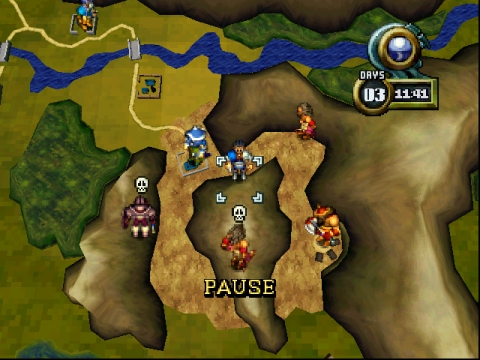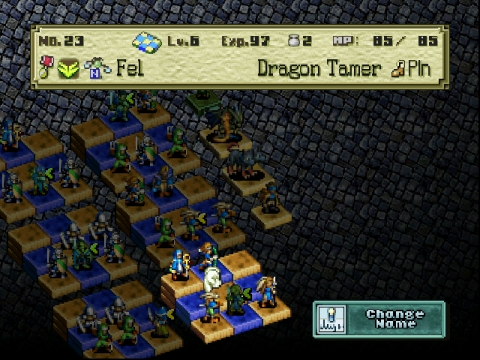Obscure(?) Games You May Not Have Heard Of - Episode 5, Ogre Battle 64 Person of Lordly Caliber
My Favorite RPG
I’m really stretching the title of this series today. You probably HAVE heard of Ogre Battle. It’s not really that obscure. Though depending on who you are you’re not likely to have played it, and if you have, you’d played Tactics Ogre or MAYBE March of the Black Queen. Tactics Ogre is a spinoff that’s loved WAY more because it’s Final Fantasy Tactics 0.5, and March of the Black Queen is easier to port and was a SNES cult classic. Person of Lordly Caliber gets far less attention.
So mostly I just wanna gush about it, because it is my favorite N64 game, and my favorite RPG of all time, and I just wanna gush about it, okay?
Plus every time I talk about it I get someone who goes “oh I’ve never played that I should check it out” and yes you should btw, if that person today is you.
__snap0000.jpg)
Ogre Battle 64 is an RPG for the N64 in 2000, and a member of the genre I like to call “Grand Strategy RPG”. What are other examples of Grand Strategy RPGs, you may ask? Well, there’s Ogre Battle: March of the Black Queen, the prequel to this game… and that’s about it. Maybe Dragon Force 1 and 2 on Saturn count too, but those are games for another day. There was also Symphony of War: The Nephilim Saga from earlier this year, but… ehhn.
It’s also the best RPG for the N64, a console that was not known for them, though it does face stiff competition from Paper Mario. Not so much Quest 64, which lags behind slightly, and Ayden Chronicles, which sits in the back of the class on its iphone all day.
If you’ve played any of the other games in the series, you know the name Yasumi Matsuno. He made Black Queen, then made Tactics Ogre. Afterwards, he quit Quest and went on to make Final Fantasy Tactics, which as I said, is just Tactics Ogre again but with more Final Fantasy this time. Also it’s boring as hell, but that’s a rant for another day. He’s then never looked back on Ogre Battle and doesn’t seem to give a shit about it anymore, because everything he does is about Ivalice now. Oh, also he has a habit of naming everything after Queen songs.
Person of Lordly Calibur is not made by Matsuno, which you can tell because it’s not named after a Queen song. Maybe this game should have been called I Want To Break Free instead, because it’s all about revolution. You play as Magnus Gallant, a young member of a military noble family who joins the army after graduating from the academy. He lives in the country of Palatinus, which is a puppet kingdom under the control of a foreign papacy called Lodis. Magnus goes to the Southern province, the poorest province, where a revolution is brewing, stirred on by noble incompetence and ire towards the lower classes, lack of freedoms, and just poor living conditions in general. Also there was a revolution against corrupt nobles in the country to the south, Zenobia, the setting of the last game. That probably won’t come up!
__snap0036.jpg)
“Liz, why the hell are you rambling about politics in this post about a game I haven’t heard of” GOOD QUESTION, VOICE IN MY HEAD! This game has its politics be…. PRETTY BLUNT, and it’s a very big part of it. The rich and “noble” class is usually filled with either wide eyed idealists who are hated by their fellow nobles and treated with suspicion or hostility by the working class (and are easily controlled, like Yumil), or its filled with fuckers like Rhade, who kill people willy nilly “to make a statement”, and treat anyone below their station as dirt. The politics of this region, and the country it takes place in, with its history, its rulers, and its important figures, is vital to the plot. This game gets into a lot, and it gets deep into its world. Religion also plays a VERY large part, because Lodis has their own religion they force upon their servant state, Palatinus, and it gets heavy.
The story is quite good, but it has some flaws. It introduces characters who are cool but then kinda don’t show up and aren’t as important later on, which is a flaw in the game in general. This isn’t Fire Emblem, characters don’t have supports with each other. Each character MIGHT have at own they’re important in, and if they go back there the citizens there will give them a special item. Characters like Asnabel, who are important plot characters for a single mission (save Asnabel, the leader of a union basically), will join your party and then NEVER MATTER AGAIN.
__snap0007.jpg)
For the most part, you’ll be following the story of Magnus and Prince Yumil, and this is the point in which I bring up that this game is HELLA gay. Like, it’s extremely obvious and heavily implied. Magnus and Yumil don’t french each other, but it goes like just before that point. This is a spoiler for a late chapter, but if you want IMPLICIT, here is implicit. There is no heterosexual explanation for this.

Liz, gay noble boys is all well and good, but whats the actual gameplay like? Well I’m glad you asked. The game takes place in three different stages, I’d say. You start a mission, and you have a map like this. you need to command your units to move around this map, flanking enemies and taking strongholds. Everything is real-time basically, with a day-night cycle, and your character’s directions matter. They can be snuck up upon and suddenly fought from behind. And speaking of fighting…

Once units collide, you FIGHT IT OUT! and now you’re in a battle. It’s kind of like an… auto-chess. You have no actual control over this battle, other than a general “hey, focus the weakest/strongest/leader unit pls”. Units will attack based on their class, and location on the field. For example, archers will attack twice in the back, but only once in the front. Mages will use their stick to bonk people if they’re in the front, they’ll cast magic twice in the back. That leads us to our third gameplay element….

Army Organization, micromanagement, and strategy are VERY important to this game. You can fiddle with your units, micromanaging them down to the equipment they wear. You can change their classes, with a LOT of classes to choose from. The layout of your army is practically infinite, and entirely up to your tastes. I find this extremely fun.
And it also helps that the graphics are SO nice. I just love this artstyle. This pre-rendered 3D art digitized into 2D sprites style works amazingly here, and makes for striking and pretty battle sprites.

Lookit this sorceress’ drip. God, she is powerful.
And…. that’s the game! Over 50 missions, over 40 hours of gameplay, have fun! Obviously there’s more to it than that, and here’s where I talk about the game’s one major flaw, the flaw that made me rate this game a 9/10 instead of a 10/10 for my N64 Quest sheet. The game has an Alignment feature for each character. This is NOT the Chaos Frame feature, which I’ll explain in a second. A unit has a personal alignment from 0-100. This alignment dictates a few things, but especially what unit they can be. Alignment is supposed to go down when you kill lots of units or attack units with a lower level than you, and go up from fighting units with a higher level than you. You can tell from my “supposed to” that this system does not work well. Sadly, I find that almost always, units will just gain alignment with no way to stop it. And now you can’t have death knights or liches, cause your whole army is good. Also it fucks with your Chaos Frame, which I’ll talk about now
The game has a hidden number called your Chaos Frame. It represents how good you as a leader are. If all you care about is conquering and winning battles, it goes down. It determines what units will join you, some only join a high chaos frame game, or a low one. The criminal werewolf will only join you if you’re kinda evil, for example. A few dialogue choices dictate your chaos frame, but the main way its dictated is by liberation. If you move a unit into an enemy controlled town, they can either conquer or liberate. If their alignment lines up with that city’s morale, it’s liberated and your chaos frame goes up. So, 0-33 = chaotic, 34-66 = neutral, 67-100 = lawful. The game DOES NOT tell you this, anywhere. Not even in the manual.
It’s a pretty complex game as it is, especially with unique systems for some special classes, like the dragoons, but this is kinda unexcusable to me, especially with the broken alignment system. Thankfully, the game has a glitch where you can duplicate any item. Just duplicate the items that raise/lower alignment, and keep an eye on your units’ alignment. Or just leave it up to god and let fate decide what kinda ending you get, that’s prolly the intended way to play, but it frustrates me.

Other than that, the game is basically perfect in every way. Good engaging story, fun characters, really enjoyable gameplay loop, great graphics, amazing music by THE Hitoshi Sakimoto (same composer for Final Fantasy Tactics), and lots of content, alongside lots of side content. Maybe use a gamefaq tho, there’s lots of missable stuff. Also it can be slowpaced for some, a speedrun button on an emulator can help that. And since this game was last released on the Wii U shop, that’s basically the only way you’re playing it.
OB64, to me, feels… abandoned. Unwanted. Matsuno, as I said, abandoned the series to go live in Ivalice for the rest of his life, and despite this game having a sequel hook and labelling itself like “chapter 5 of 8” or whatever, pulling a Star Wars, it never got a sequel. Quest was bought by Squeenix, who ignored the series forever, and no one seems interested to pick it back up, except to give TACTICS OGRE YET ANOTHER REMAKE.
This genre, the Grand Strategy RPG, died here, never given a true chance to flourish. I don’t think it deserves that. This game is amazing, and it’s kinda a meme in my community that I push it too much (“hey have you heard about OGRE BATTLE 64? I never bring it up, but-“). But please, if you’re gonna play any game I talk about on here, play this one lol
Maybe some day I’ll talk about March of the Black Queen too, which… I do not like as much. It has lots of flaws that this game ironed out. Some day.